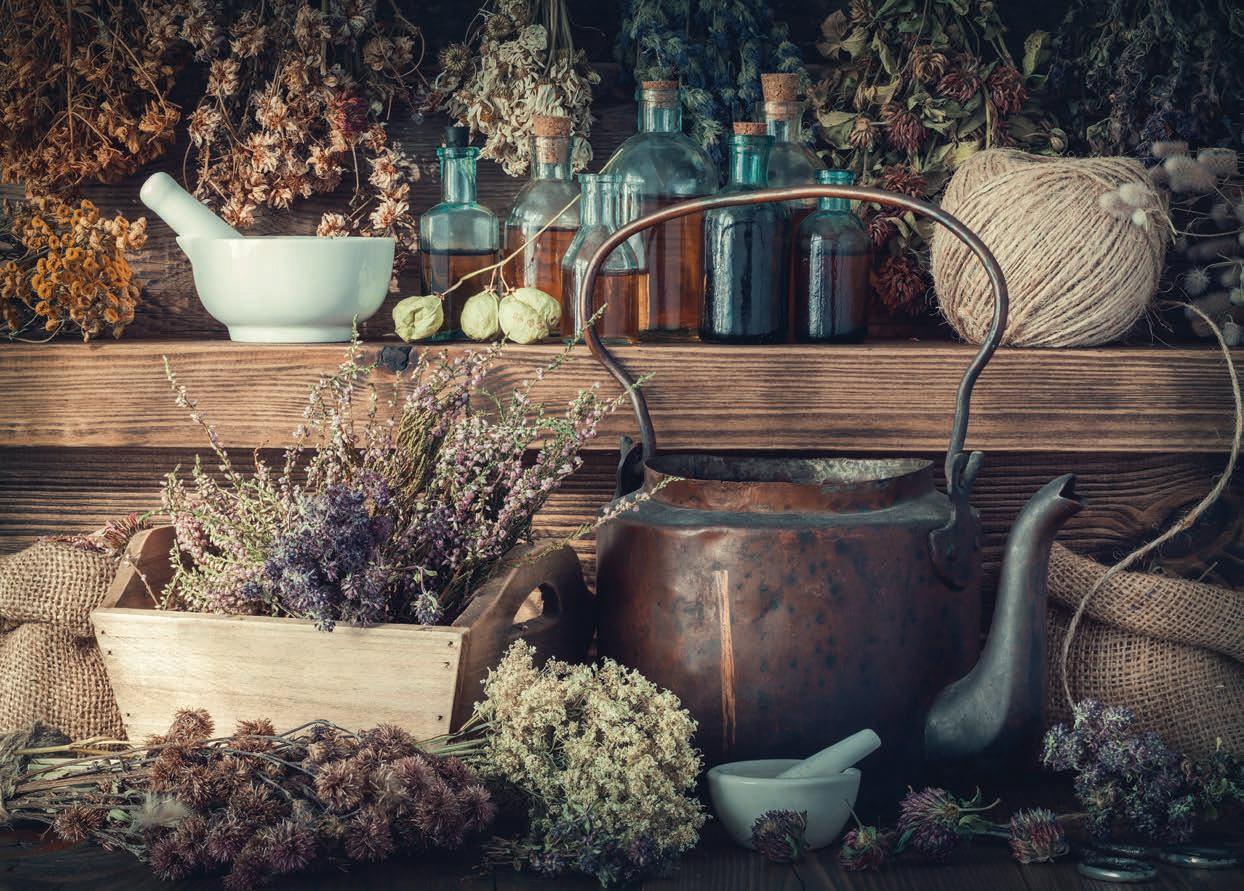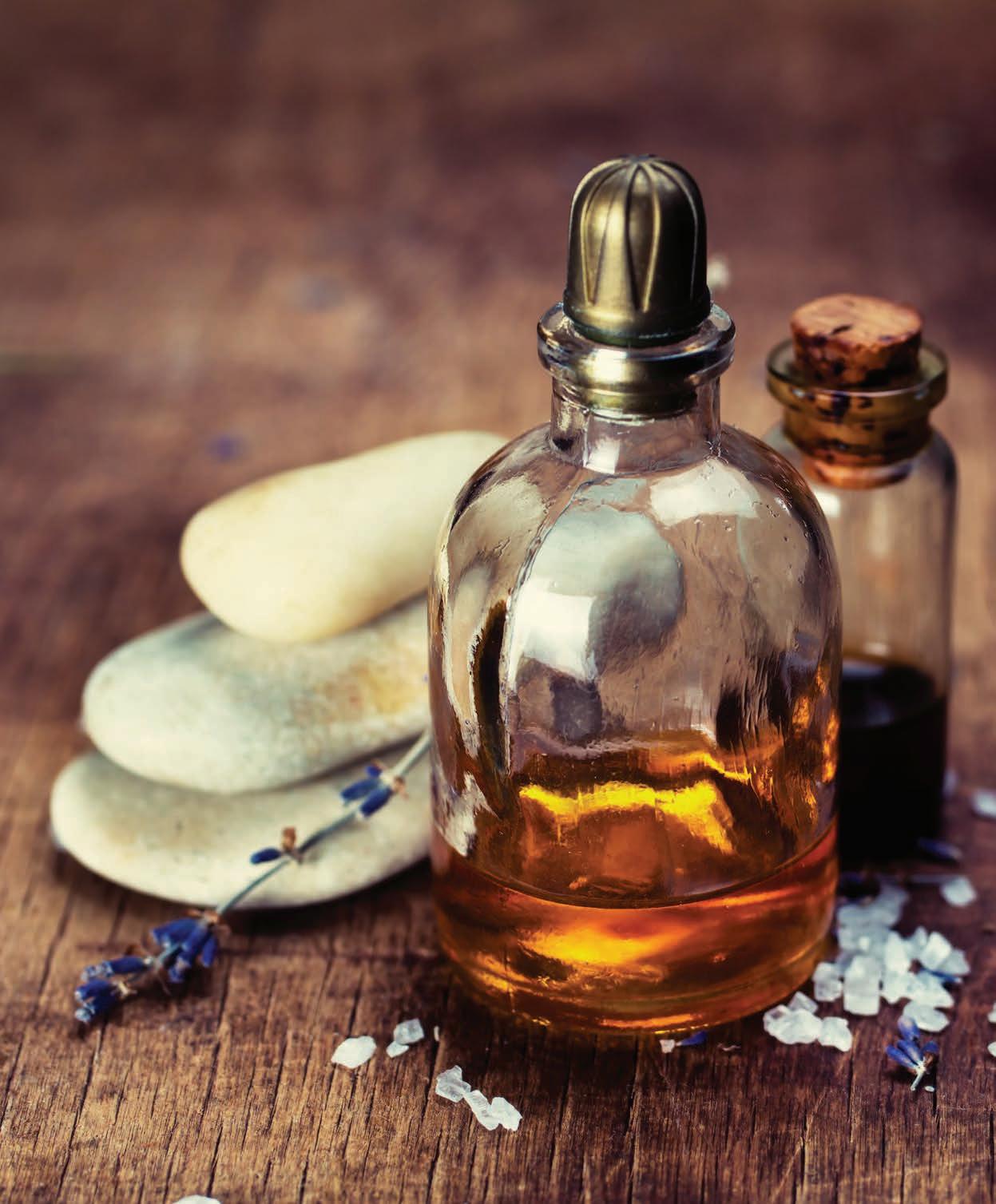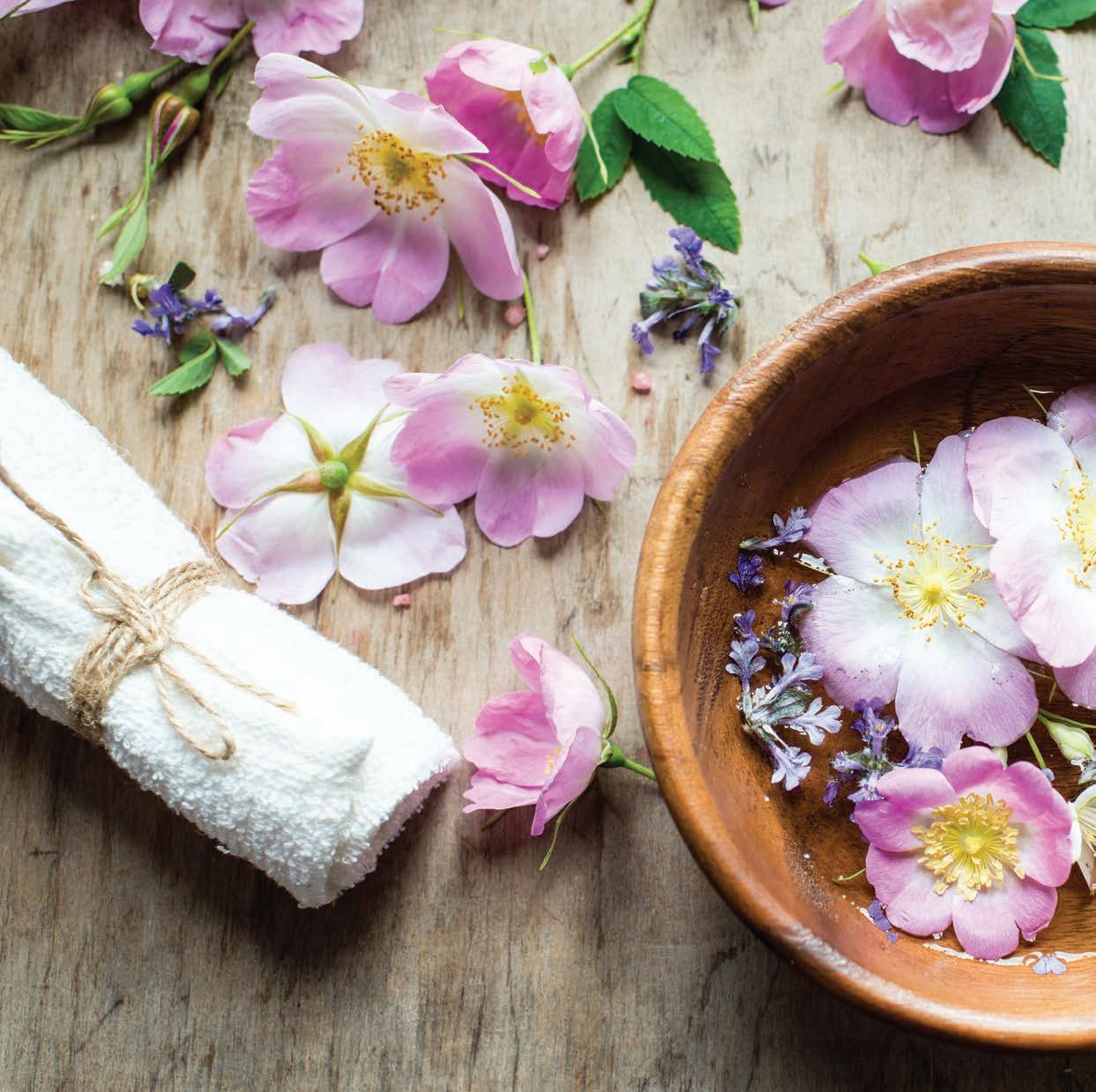
13 minute read
Homemade herbal preparations
plant material and pour the liquid into small, labeled, glass bottles with dropper tops. The common ratio of finely chopped fresh herbs to ethyl alcohol stands at 3.5-4.5 oz (100-125 g) of fresh herbs to 17 fl oz (500 ml) of 60%-65% ethylalcohol. Ethylalcohol also acts as an effective preservative. Alcohol-based tinctures have a virtually unlimited shelf life if stored in a cool, dark location. Refrigeration is not necessary. The non-alcohol version of tincture is extracted in organic vegetable glycerine and distilled water. Although it may be tempting to make your own tinctures, some plant parts are considered toxic and may be harmful. In addition, certain plants may be contaminated by substances such as pesticides and heavy metals.
There is a lack of research on many of the tinctures that are commonly used. If you’re considering making and trying one, consult your health care provider to discuss whether it’s appropriate and safe for you.
Advertisement
HONEY TINCTURE Honey tincture is made from a mixture of herbs, alcohol and honey. This combination ensures extraordinarily fast and effective absorption of medicinal compounds. Use preferably fresh herbs. Fill a mason jar 1/3 of the way full with finely chopped herbs. Pour 40% vodka over the herbs covering them completely with the alcohol, and keep pouring until the alcohol is 2 inches above the herbal material. Cover with an airtight lid and let sit in a warm place but not in direct sunlight for two weeks. Then open and stir 7 oz (200 g) honey into the content and shake well. The next day the tincture is ready to use. Unless otherwise prescribed take 1 teaspoon of the tincture 4
times a day. Strain through a stainless or plastic sieve, ideally with a glass spoon. Then pour about 4 fl oz (125 ml) distilled or boiled water over the pomace, stir it and drink on an empty stomach.
EXTRACTS Herbal extracts are preparations containing plant produced compounds (phytochemicals), which possess medicinal properties, in concentrated form. Extracts may be prepared by allowing tincture to evaporate in a vacuum if possible – which indicates that this method is not suitable for making extracts at home. A liquid extract is obtained by letting the orginal tincture ratio of 1:5 (1 part herb, 5 parts ethyl alcohol) evaporate to 1:1. By further evaporation up to honey-thick consistency you will get a thick extract. Complete evaporation results into in a small amount of extract powder.
MEDICINAL WINES There are two common methods to make medicinal wines: wine concoctions (less often infusions) or wine macerations. Concoctions are intended for immediate consumption and are therefore prepared in small amounts while macerations are intended for gradual consumption. Macerations may last minimum four months when stored in full sealed bottles and even much longer when stored in a cool place. Once the bottle has been opened the content should be used within three weeks. If the maceration is to be consumed in small amounts it is advisable to pour it into small bottles and keep the bottles full and sealed. To prepare medicinal wines use the same method as to prepare herbal teas. Wine concoctions (infusions) have a much stronger effect than water infusions like teas. It is therefore advised to use a little fewer herbs than when you make a tea, or dilute the wine with a little water, or shorten the infusion time. Medicinal wines in general should be served in small amounts, usually in tablespoonfuls. As to wine macerations the most suitable concentration seems to be 2.5 oz (75 g) herb to 34 fl oz (1 l) wine. To make white wine macerations use Rhine or Italian Riesling and to make red wine macerations Cabernet or Merlot is recommended.
MEDICINAL HERBAL VINEGAR Since ancient times, medicinal vinegar preparations were made by macerating both medicinal or culinary plants. Vinegar extracts the medicinal constituents of herbs, yet also carries many healing properties of its own., e.g. vinegar tonifies, cleanses and cools the skin, improves digestion and metabolic functioning or moderates high blood pressure.
Medicinal herbal vinegars can be prepared by macerating herbal material in table wine, red or white, usually in a 1:10 to1:12 ratio, and adding 3 tablespoons of wild yeast vinegar or vinegar of your choice (champagne, raw apple cider...). The wine soon starts to acetify. Fill one-pint jar 2/3 with the macerated herbal material and cover it with room temperature apple cider vinegar. Cap the jar with a plastic lid or put a plastic bag between the metal lid and jar so that the vinegar will not corrode the metal. Let sit for minimum 5-6 weeks, the longer it sits the more flavor and herbal absorptionis made by the vinegar , and shake occasionally. Strain or keep herbal material in and use it on your food.
HERBAL JUICES Many herbs can be juiced, especially plants that contain a large amount of water and those that have water soluble medicinal compounds work best. To make a tasty herbal juice use a high-quality (not centrifugal) juicer, or a horizontal juicer to grind herbs. Herbal juices can be preserved for later use by thermal processing or sterilization, but it is obviously better to consume them fresh. In summer they can last minimum 2-3 days in the fridge, in other seasons about a day longer. Juices made from herbs which are not fleshy should be taken in teaspoons or tablespoons once or twice a day. Juices from fleshy herbs, fruits or vegetables can be consumed several times a day, however moderation is advised because of the amount of sugar the apparently healthy drinks contain. Juicing releases the sugars in fruit and removes the insoluble fibre, which is important for our health. Therefore, you will be better off making your own juice so you can control what goes into it, and limit their intake to a couple of glasses a week as a ‚nutritional top-up“. If you cannot consume juices for whateever reason try vegetable stocks instead and preferably serve them fresh.
HERBAL OINTMENTS They are also very easy to make, they last for months and don’t contain any of those harmful chemicals you would normally find in the store bought creams and
MEDICINAL OILS A popular method of preparing medicinal herbal oils is to dissolve essential oils in carrier oils. Carrier oils, such as natural vegetable oils, are used to dilute essential and other oils prior to topical application because if applied to the skin undiluted, essential oils can cause severe irritation, burning or other reactions in some individuals. Another method is purely natural: for one part of herbal material (ideally, fresh crushed herbs) you will need 7-8 parts of carrier oil. Put all parts together into an open container and heat in a water bath for about 30 minutes. Remove the container, cover with a lid and let sit in room temperature for about five days and then filter.

ointments. Ointments are similar to creams, but unlike a cream that quickly absorbs into the skin, ointment forms a protective layer over the skin as they do not contain water, just oils or fats. Herbal ointments can be prepared from dried herbs or tincture by slowly stirring drops of heated tincture or finely ground herb powder into a melted ointment base. Calendula flowers, for example, can be infused directly in the melted base. The consistency of an ointment can be adjusted by adding melted beeswax or resin.
HERBAL COMPRESS AND POULTICE Herbal compresses are usually made by dipping a soft cloth into the herbal tea. Instead of cloth you can use washed and tenderized leaves, e.g. of kale. A herbal plaster is a kind of herbal paste made from fresh or dried herbs mixed with water or oil typically thickened with starch or flour, or clay. You can choose to put this paste on a cotton cloth and then directly against your skin, or you can put a cloth between your herbal paste and your skin as a kind of buffer as some herbs may be irritating to the skin.
HERBAL BATHS When choosing to take a hot bath, make sure to include healing herbs. But remember, never immerse yourself in extremely hot bath water and always end your hot bath with a short cold shower to prevent developing a disease. Herbal baths combine the beneficial effects of herbs, water and heat and are recommended to be taken twice or three times a week. The bath water temperature should be just a degree or two higher than normal body temperature. The average time spent in the bath ranges from 10 to 20 minutes, but should not exceed 35 minutes. A comprehensive spa treatment generally includes 12 baths followed by a few days break and then 4 more baths to complete the treatment. However, partial baths, such as hand or feet or lower back baths, have an unexpectedly comprehensive effect as well and are not as exhaustive as complete baths. For a partial bath use 3-5 teaspoons of herbal mixture, and 8-15 teaspoonful for a complete bath. Unless a decoction is explicitly prescribed infuse herbs in hot water (from 16-50 fl oz or 0.5 -1.5 l) and let cool off. Then strain and add to the pleasantly warm bath. Watch out, repeated complete bath may sometimes result in temporary worsening of symptoms. An overly strong or recurring reaction to hot baths may indicate the necessity to suspend the treatment. Consult your balneologist.
HERBAL SYRUPS Herbal syrups offer powerful and concentrated medicine and nutrition. There are more ways to make them, but remember you will always need a lot of sweetener to make the syrup taste well and last long. No-heat herb and sugar syrup: You can make delightful, fragrant syrups by packing a layer of fresh herbs into a clean jar and pouring white sugar over it. Then put another layer of herbs on top of the sugar, and repeat several times until the jar is full. Then seal and place the jar in a warm place for about one month to get a tasty natural herbal syrup. Herb infused simple syrup: Carefully rinse your herb or a mixture of herbs. Bring a cup of water to a boil. Add a cup of white sugar and whisk into the boiling water until the sugar is dissolved. Add herb of choice to the syrup and let boil for 60 seconds. Remove from heat and let the herbs steep for about 30 minutes as the syrup cools. Pour the cooled syrup through a fine strainer into a glass bottle or jar. Store in the fridge and add to your favorite drinks in teaspoons for a sophisticated herbal essence.
HERBAL ENEMAS People have long used herbal enemas for a variety of health reasons. Some believe enemas are essential as a routine bowel cleaning measure, while others believe they can help with removing toxins from the body. The effect of enemas depends on the absorptive capacity of intestinal mucosa. Enemas are recommended for bowel disease, or when patients reject oral medication. First, take a cleansing enema. Infuse 50 fl oz or 1.5 l of boiled, filtered and slightly salted water of body temperature into your colon to stimulate peristaltis throughout the full length of the colon. Once enough water is in the colon, you then expel it, along with the resulting waste into the toilet. Only then perform the medicinal herbal enema . Herbal enema recipes are simply enemas where water is infused with herbal remedies. However, you need much less water, between 5-7 fl oz or 150-200 ml, as you do not need to stimulate peristaltis this time, but you want the herbal tea to remain in the bowels and heal. As regular enemas somewhat irritate the intestinal mucosa, so-called micro-enemas are sometimes more advisable. Spray 4 fl oz or 125 ml of healthy herbal tea into the bowels (right after the bowel movement) with no need to induce further cleansing. Micro-enemas have a gentler effect than traditional enemas, which makes them more suitable for repeated use.
HERBAL INHALATIONS Herbal inhalations are split into wet types (when we inhale vapors of boiling herbs such as chamomile, juniper or mint through linen) and dry ones – which border on aromatherapy, and in which we inhale compounds finely spread in the air, or when we inhale the natural air of a forest or meadow. The advantage of inhalations is that they come into effect very quickly – essentially as fast as when using preparations intravenously.

HERBAL POWDERS Herbal powders are wonderful daily remedies. They can be added to juices, smoothies, honey or milk for internal use, or mixed with oils, water or honey for external application. Topically, they can be used to quickly create a compress. Mix the finely ground herbs with a little water, oil or honey to make a paste and rub it on the affected body part and cover with a cloth. Store sealed airtight in a cold dry place. Internally, take one teaspoon after a meal and wash down with a glass of water or tea.
Drying Herbs While the herbs from your garden are best when used freshly picked, there is always more than you can use in one season. Air drying is not only the easiest and least expensive way, but this slow drying process can help retain the essential oils of the herbs, so they don’t lose all their flavor. The ideal temperature for drying herbs ranges from 95°- 104° F or 35°- 40° C. If this temperature would be difficult to ensure, dry the herbs in a shaded well ventilated place.
Harvest herbs for drying just before their flowers open. As for the time of the day , generally it is best to harvest herbs early morning after the dew has evaporated but before the sun has evaporated the volatile oils contained in them. Rinse them with lukewarm water, pat them dry with paper towels, remove any dry or diseased leaves. Hang or lay the herbs out where they will get plenty of air circulation, so they can dry out quickly. Wet herbs will mold and rot.
Tie them into a bundle with a rubber band. Keep the leaves and flowers facing downward and hang somewhere in a spot that gets full sun, e.g. on the porch or off a hanger or a drying rack. Another common way is to lay them out on the floor with a thin white paper underneath, but it is also the slowest method, which may result in a poor condition of the herb at the end of the process. The drying process may last up to several days depending on the type of herb and the thickness of the layer.
Herbs can also be dried in an oven or microwave, which is a much quicker method than air-drying, though you will have to be careful not to burn the herbs, and you may have to experiment with your oven to find the ideal technique.
Once you have dried your herbs, they are ready to use right away, but more often you will want to store the herbs for later. Crumble the dried herbs with clean fingers or crush them in a mortar, discarding any hard stems. Then place the crushed herbs into small airtight containers and keep in a cool, dark place. They may last for 6 to 12 twleve months, but the sooner you use them, the more flavor you will have.











